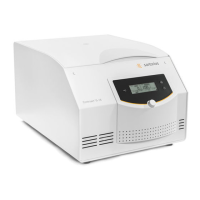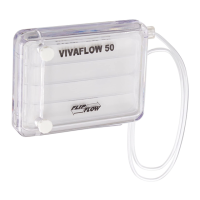2 Layout and mode of operation
Version 09/2015, Rev. 1.3 of 02/03/2017
Translation of the original operating manual, WZG6001-e150401
Pos: 21 /100 Sigma/10 0 BA Zentrifugen Sigma (Sta ndardmodule)/02 0 Aufbau und Wir kungsweise /020-0020 Wirk ungsweise-- --------------- ------------------ --------------- -------- @ 26\m od_140531898 4194_68.docx @ 191807 @ 2 @ 1
2.2 Mode of operation
Pos: 22 /100 Sigma/10 0 BA Zentrifugen Sigma (Sta ndardmodule)/02 0 Aufbau und Wir kungsweise /020-0020-00 10 Prinzip der Zentr ifugation @ 26 \mod_1405 318985448_68. docx @ 191821 @ 3 @ 1
2.2.1 Centrifugation principle
Centrifugation is a process for the separation of heterogeneous mixtures of
substances (suspensions, emulsions, or gas mixtures) into their components. The
mixture of substances, which rotates on a circular path, is subject to centripetal
acceleration that is several times greater than the gravitational acceleration.
Centrifuges use the mass inertia inside the rotor chamber for separating the
substances. Due to their higher inertia, particles or media with a higher density
travel outwards. In doing so, they displace the components with a lower density,
which in turn travel towards the centre.
The centripetal acceleration of an object inside a centrifuge, as the effect of
centripetal force, depends on the distance between the object and the axis of
rotation as well as on the angular velocity. It increases linearly as a function of the
distance with regard to the axis of rotation and quadratically as a function of the
angular velocity. The bigger the radius in the rotor chamber is and the higher the
speed is, the higher the centripetal acceleration is. However, the forces acting on
the rotor also increase.
Pos: 23 /010 Unive rsalmodule/ Lee rzeile @ 0 \mod_1202116244 500_0.do cx @ 114 @ @ 1
Pos: 24 /100 Sigma/10 0 BA Zentrifugen Sigma (Sta ndardmodule)/02 0 Aufbau und Wir kungsweise /020-0020-00 20 Anwendungsber eich @ 26\mod _1405318986 763_68.docx @ 191835 @ 3 @ 1
Das
2.2.2 Area of application
Depending on the area of application of the centrifuge and also on the particle
size, solids content, and volume throughput of the mixture of substances that is to
be centrifuged, there are different types of centrifuges.
The areas of application go from household use as a salad spinner or honey
separator up to specialised technical applications in the clinical, biological, or
biochemical context:
For numerous clinical examinations, cellular material must be separated from
the liquid to be analysed. The normal separation process can be sped up
considerably by using laboratory centrifuges.
In the metal-working industry, centrifuges are used for separating oil from
cream and low-fat milk.
Particularly big centrifuges are used in the sugar industry for separating the
syrup from the crystalline sugar.
Ultracentrifuges are predominantly used in biology and biochemistry in order
to isolate particles, e.g. viruses. They are specifically designed for high speeds up
to 500,000 rpm. The rotor moves in a vacuum in order to avoid air friction.
Pos: 25 /010 Unive rsalmodule/Seite nwechsel @ 0\mo d_120211624 4312_0.docx @ 105 @ @ 1

